Going for the Green
Air Date: Week of August 8, 2008
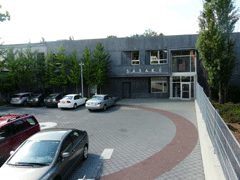
Sasaki Associates’ master plan for the Beijing Olympic site won the international competition. (Photo: Bruce Gellerman)
Eastern architectural traditions and Western contemporary design meet at the Beijing Olympic Green. A Massachusetts architectural firm won the international competition to design the Olympic master plan. Bruce Gellerman reports that the firm designs globally and practices what it preaches locally.
Transcript
GELLERMAN: It’s Living on Earth, I’m Bruce Gellerman.
It’s an architect’s dream: you’re given a huge parcel of city space and told to lay the groundwork for a world-class event. Well, for Dennis Pieprz, it was a dream come true. Pieprz is president of the architectural firm, Sasaki Associates, and he remembers the day well. It was six years ago, mid-July, a Sunday. Pieprz was in his office, catching up on some work, when one of his employees, who was reading a Chinese newspaper online, got excited.
PIEPRZ: And he suddenly jumped up, and said, ‘We won! We won!’ And I wasn’t expecting to hear any news so I didn’t have any idea what he was talking about and he said, ‘We won the Beijing Olympics competition!’
[OLYMPIC THEME]
GELLERMAN: Sasaki Associates came up with the design for the 29th Olympiad, beating out 92 competitors around the world. China challenged all comers to create a master plan for the Beijing Games using a 2,500-acre plot of land incorporating a forest park, little used agricultural fields, and some buildings left over from the 1990 Asian Games. Just as the Chinese proverb says, ‘a journey of a thousand miles begins with a single step,’ so too creating a master plan for the Games begins with a design concept, or what Pieprz calls, ‘a framework for the Olympic Green.’
PIEPRZ: It’s really trying to understand what the essence of the place is about because we wanted the Olympic Green to be all about China, not an importation of a Western idea.

Sasaki Associates’ master plan for the Beijing Olympic site won the international competition. (Photo: Bruce Gellerman)
GELLERMAN: Traditional Chinese urban design lays out streets in neat grids and uses gateways to enclose large places like Tiananmen Square and the Forbidden City- monumental sites built on a north-south axis.
PIEPRZ: Our idea was to develop a concept that would be highly connected and integrated with the existing city- but not any of the adjacent neighborhoods and district, but the real heart of the city. And so we organized our scheme around this great north-south axis.
GELLERMAN: Sasaki designers wanted to maintain traditional ways- with a twist. Along the great north-south axis connecting Beijing’s great historic sites is where Pieprz’s planners designed East would meet West. They placed the National Stadium to the right of the axis, and the Water Sports facilities to the left, creating a gateway effect: Eastern essence, with a modern Western flavor.
PIEPRZ: We decided to put the stadium off the axis, letting the axis run through, really for future generations to deal with, and felt that people needed to be at the center of the place- not an object or some stadium that may last who knows how long.
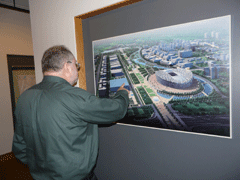
Dennis Pierprz, president of Sasaki Associates, points out features of the design of the Olympic Green. (Photo: Bruce Gellerman)
GELLERMAN: Pieprz’s goal was to create a site that was sustainable. He’s keenly aware that Olympic games can be a sporting success, the site can be a failure in the future. It happened after 1976 at the Montreal Olympics and the 2000 Games in Sydney, Australia.
PIEPRZ: The problem in Sydney is that the Olympic site and its Olympic-produced facilities were hardly being used. And they had some of the most incredible public spaces and investment in public space and here was an area that for example, the arena only used like 29 times a year, the stadium only 10 times a year for rugby.
GELLERMAN: Pieprz says the way to connect a new urban district with an existing city is to take advantage of population density, designing a site that puts people, not buildings, front and center, providing them with access to public transportation and proximity to facilities they’ll need and use. For Beijing, the Sasaki plan calls for 28 million square feet of new buildings- buildings most Olympic viewers will never see.
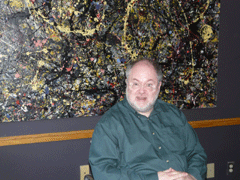
Dennis Pierprez, president of Sasaki Associates. (Photo: Bruce Gellerman)
PIEPRZ: Only a small fragment of the overall plan is actually built. But our plan and the city’s goal was to create a new district- a mixed-use district. So coming after the Olympics is a whole array of other uses like hotels, retail, commercial. All going to much more strongly define the major spaces that have been built for the Olympics.
GELLERMAN: When you watch the Olympic games you’ll be looking at a site in China, designed by a firm founded by a Japanese Architect, lead by a native born South African, based in Watertown, Massachusetts, a city located half a dozen miles west of Boston along the Charles River.
[DRIVING, WATER NOISES]
GELLERMAN: A dam built more than 200 years ago once powered the series of mill buildings that make up Sasaki’s world headquarters here in Watertown. It’s where the sails for the USS Constitution, Old Iron Sides, were made.
MCCOWAN: You can imagine that the most sought after desk locations are right here along the river, where you can open window and listen to the sound of the river.
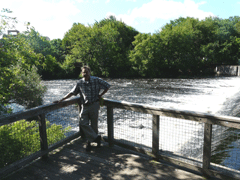
Jim McCowan, director of communications for Sasaki outside the company’s building on the Charles River. (Photo: Bruce Gellerman)
GELLERMAN: Jim McCowan, is a spokesman for the architectural company. In keeping with Sasaki’s work principles: design globally, act locally, they’re put into practice what they preaching for the Olympics: putting people at the center of the project. At corporate world headquarters in the renovated mill buildings, the prime locations along the Charles River are public spaces: a library and cafeteria. And today, sustainability is a priority.
MCCOWAN: And you know back then the environment not a priority, and so obviously there was a lot of pollution that took place. So now in some ways we're making up for it.
GELLERMAN: And how! Sasaki updated and refurbished the old factory using green design concepts and materials. Meredith Elbaum, is director of sustainable design at Sasaki
ELBAUM: You know to tell you the truth and may be this is inspiration for other people, I think it’s a lot of common sense. I mean we really haven’t done a lot of radical things.
GELLERMAN: They use recycled materials when possible, environmentally sound cleaners, carpets and paints. Workers get free public transit passes, hybrid drivers get choice parking spaces. And once a year employees goes dumpster diving to see how much more they can recycle.
Meredith Elbaum says they also studied using the old waterfall to generate electricity, but it would be too expensive. One big thing that did pay off: Sasaki installed automatic light dimmers. Workers don’t notice the change, but the electric company sure did:
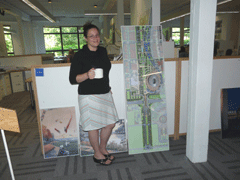
Meredith Elbaum, director of sustainable design at Sasaki. (Photo: Bruce Gellerman)
ELBAUM: It got to a point that the utility actually came by because they though our meters were broken because we had reduced our electricity so much by 34 percent in two years, they thought our meters were broken.
[OLYMPIC THEME MUSIC]
GELLERMAN: Victory again for Sasaki Associates, the company that won the international design competition for the Olympic Green, recently received the U.S. Green Energy Building Council’s Gold LEED certification, making the firm’s headquarters the oldest building in the nation to win the coveted award.
[OLYMPIC THEME MUSIC CONTINUES]
Links
Living on Earth wants to hear from you!
Living on Earth
62 Calef Highway, Suite 212
Lee, NH 03861
Telephone: 617-287-4121
E-mail: comments@loe.org
Newsletter [Click here]
Donate to Living on Earth!
Living on Earth is an independent media program and relies entirely on contributions from listeners and institutions supporting public service. Please donate now to preserve an independent environmental voice.
NewsletterLiving on Earth offers a weekly delivery of the show's rundown to your mailbox. Sign up for our newsletter today!
 Sailors For The Sea: Be the change you want to sea.
Sailors For The Sea: Be the change you want to sea.
 The Grantham Foundation for the Protection of the Environment: Committed to protecting and improving the health of the global environment.
The Grantham Foundation for the Protection of the Environment: Committed to protecting and improving the health of the global environment.
 Contribute to Living on Earth and receive, as our gift to you, an archival print of one of Mark Seth Lender's extraordinary wildlife photographs. Follow the link to see Mark's current collection of photographs.
Contribute to Living on Earth and receive, as our gift to you, an archival print of one of Mark Seth Lender's extraordinary wildlife photographs. Follow the link to see Mark's current collection of photographs.
 Buy a signed copy of Mark Seth Lender's book Smeagull the Seagull & support Living on Earth
Buy a signed copy of Mark Seth Lender's book Smeagull the Seagull & support Living on Earth

